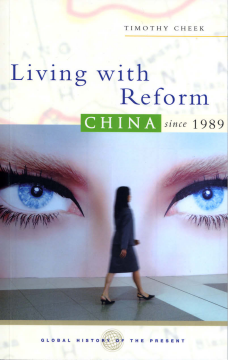
Additional Information
Book Details
Abstract
China is huge. China is growing more powerful. Yet China remains a great mystery to most people in the West. This contemporary history, based on the latest scholarly research, offers a balanced perspective of the continuing legacy of Maoism in the lives not only of China's leaders but China's working people. It outlines the ambitious economic reforms taken since the 1980s and shows the complex responses to the consequences of reform in China today.
Cheek shows the domestic concerns and social forces that shape the foreign policy of one of the worlds great powers. His analysis will equip the reader to judge media reports independently and to consider the experience and values not only of the Chinese government but China's workers, women, and minorities.
‘Timothy Cheek offers a remarkably comprehensive and perceptive account of Chinese history in the post-Mao era.’
Maurice Meisner, University of Wisconsin at Madison
'This is a concise, systematic and illuminating introduction to the ways in which China as a complex nation-state works and is experienced by the Chinese during the tumultuous two and half decades of reform.'
Adam Yuet Chau, University of London
'Timothy Cheek provides readers with a lively introduction to the key dilemmas facing the world’s most populous country.'
Jeffrey N. Wasserstrom, University of California
'Thought-provoking and thoroughly-argued'.
S. K. Ma, Choice
Timothy Cheek holds the Louis Cha Chair of Chinese Research in the Institute of Asian Research at the University of British Columbia. He is also editor of the journal, Pacific Affairs. His books include Mao Zedong and China's Revolutions (2002) and Propaganda and Culture in Mao's China (1997), as well as New Perspectives on State Socialism in China (1997) and The Secret Speeches of Chairman Mao (1989).
Table of Contents
| Section Title | Page | Action | Price |
|---|---|---|---|
| Cover\r | Cover | ||
| Contents\r | v | ||
| Acknowledgments | vi | ||
| Chronology | vii | ||
| Map of China | x | ||
| Preface: what does Tiananmen mean? | 1 | ||
| Picturing China: seeing beyond Tiananmen | 2 | ||
| Living with reform: what is fair and who decides? | 9 | ||
| 1 | Making sense: what is ‘China’? | 13 | ||
| China’s systems | 14 | ||
| Diversity of experience in China’s system | 30 | ||
| 2 | Living history: what was Maoism? | 32 | ||
| Maoist history: remembering the revolution | 35 | ||
| Maoist orthodoxy: ideology in a secular age | 42 | ||
| Maoist orthopraxy: continuing habits and expectations | 46 | ||
| 3 | Reform: Mao is dead, long live Mao! | 54 | ||
| Not the Cultural Revolution: the beginnings of reform | 56 | ||
| Reform and openness in the 1980s and the road to Tiananmen | 59 | ||
| Deng’s model: economic reform under Party rule | 71 | ||
| 4 | Brave new world: reform and openness | 74 | ||
| Fantasies of the Western paradise | 75 | ||
| Boom and bust on the farm | 77 | ||
| Trouble in town | 82 | ||
| The social life of joint ventures | 85 | ||
| Gendered reform and the generation gap | 86 | ||
| Ethnic reform | 89 | ||
| Elite, middle class, and the poor | 90 | ||
| Liberty and anxiety for intellectuals | 94 | ||
| Three Chinas | 99 | ||
| Two worlds: human society and natural environment | 101 | ||
| 5 | Winners and losers: reactions to \rreform | 103 | ||
| Social reactions to reform | 105 | ||
| Guojia and zhengfu: reform China’s contending governments | 108 | ||
| China and the natural world | 114 | ||
| Nationalism and the Internet | 117 | ||
| 6 | China in the world today | 122 | ||
| Ungrounded empires | 123 | ||
| China’s fragile peripheries | 131 | ||
| China Rising: the international diplomacy of the PRC | 139 | ||
| What will happen next? | 142 | ||
| Conclusion | 145 | ||
| Notes | 150 | ||
| Suggested reading | 163 | ||
| Index | 165 |
